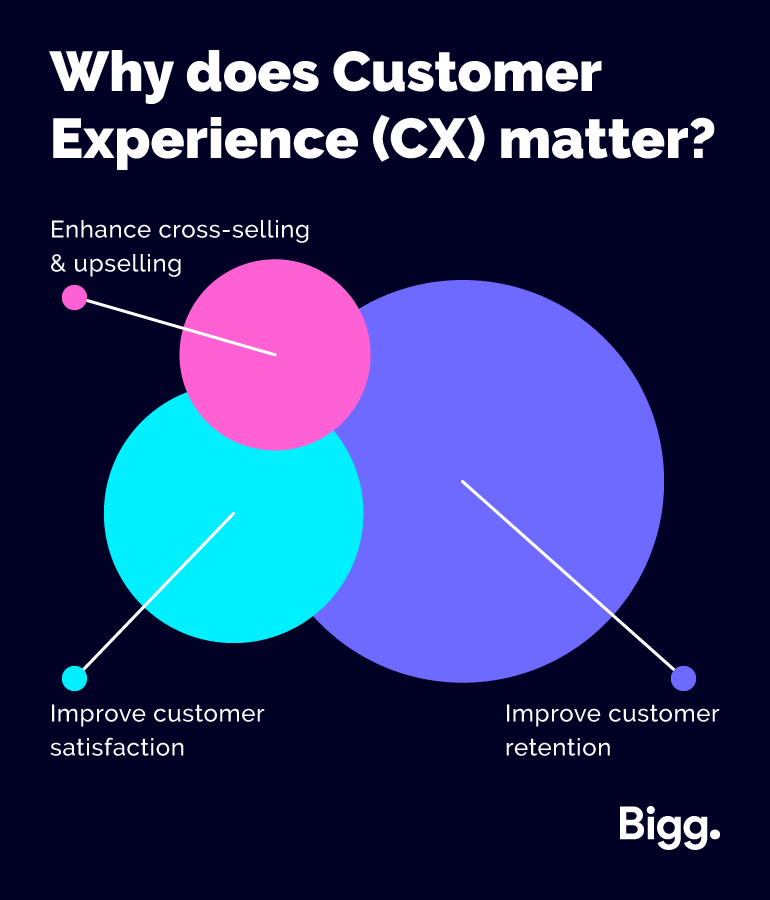If you run your own business, then you’ll have likely come across the terms ‘user experience’ and ‘customer experience’. However, the two are often used interchangeably, which can ultimately lead to missed opportunities when trying to optimise your website and services.
Read on below as we help you grasp the concept of customer and user experiences in order to effectively channel your business towards success.
Understanding CX and UX
What is CX?
Customer experience (CX) refers to your customers’ overall experience throughout every interaction with your business, from their initial engagement to ongoing support, through various different channels (e.g. social media, customer support, website).
CX is very much focused on your prospective and existing customers’ emotions, opinions and perceptions of your business.

What is UX?
In contrast, user experience (UX) refers to your customers’ interaction with your digital product, service or system and their experience throughout this specific interaction.
UX focuses less on sentiment, and more on usability.

What are the Key Differences Between CX & UX?
The most helpful way to understand the main difference between CX and UX is to look at it like this: UX refers specifically to your product or service and is included in CX, while CX also contains other aspects outside of your product or service.
Essentially, the two are not separate, combined or overlapping with one another, rather UX exists within CX.

As for their additional differences, these can be broken down into the following categories.
Target Audience
CX focuses on customers’ overall experience with your business. This could include anyone who researches your business, makes a purchase or contacts your customer support – whether it’s the same person performing all these interactions or separate individuals.
Meanwhile UX targets a smaller group, since it focuses solely on the individuals who are actively using your product, service or system, regardless of whether they initially researched or bought it.
Key Objectives
Different goals must be established in order to target the aforementioned audiences’ needs effectively.
Goals and objectives for CX could include:
- Attract, engage and satisfy customers
- Promote customer satisfaction throughout each stage of the customer journey
- Create a feedback portal where customers can voice their needs
Goals and objectives for UX could include:
- Design a seamless product/service experience with minimal pain points
- Develop products/services that are interactive, enjoyable and easy to use
- Resolve key issues customers may face throughout their experience of interacting with your product/service

Metrics
When it comes to measuring CX, you should be focusing on how satisfied your customers are with your business overall and the likeness of them recommending your business to others.
These can be measure in various ways, including:
- Net Promoter ScoreⓇ (NPS) – a measurement of customers’ overall perception of your brand and how likely they are to recommend you to others
- Churn rate and retention rate – churn rate evaluates how many customers your business loses whilst retention rate evaluates how many customers you keep over a defined period
- Customer satisfaction – the overall degree to which customers are satisfied with your business based on their various interactions; this can be measured through qualitative data such as surveys and reviews
Contrastingly, in order to measure UX you want to be testing the usability of your product or service. This can be measured by the following:
- Website load speed – the time it takes pages on your website to load content
- Task time – the time it takes customers to complete a specific goal (e.g. find the contact page on your website)
- Adoption rate – the percentage between new users and all users for your product/service
- Success rate and abandonment rate – success rate measures the percentage of users who complete a particular task while abandonment rate measures the percentage of users who leave a task before completion (e.g. the number of users who press ‘checkout now’ vs the number of users who leave items in their cart without checking out)
Why do these Differences Matter?
Distinguishing between CX and UX is a must in order to achieve the same ultimate goal: improving customer retention and ROI.
The best way to ensure this is through the combination of usability and positive brand experience, which is why both should be focused on using separate strategies.
If customers experience excellent usability but poor interaction with other aspects of your business, it’s likely that they’ll have a negative perception of your business overall. Vice versa, if they have a great general experience with your business, however face barriers when interacting with your website, this again leads them away from your business.
How Can UX & CX Work Together?
So, how do the two work together? Well, UX has a direct impact on CX, which is why you should optimise both in order to positively influence your customers’ impressions towards your business, products and services, thus increasing your chances of customer retention, ROI and business growth.
Understanding the significance of utilising both UX and CX to their fullest potential is essential to crafting exceptional products and services that resonate with your target audience, and we can help here at Bigg.
From improving brand awareness and engaging customers on your socials, to optimising your site’s content and improving your search engine rankings, let us help you by doing what we do best – delivering tangible, measurable results for your business.
What are you waiting for? Book your 1:1 strategy call with one of our experts today to discuss your goals, or get in touch for more information regarding our services.

